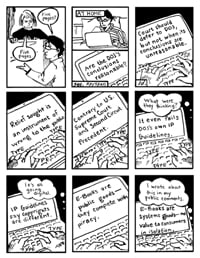 Ryan H. Flax
Ryan H. Flax
(Former) Managing Director, Litigation Consulting
A2L Consulting
As the title suggests, this post will offer a moment of levity on this Friday afternoon. On Tuesday (September 4, 2012), an attorney filed an amicus brief with the U.S. District Court for the Southern District of New York in United States v. Apple, Inc. et al. The authoring attorney is Bob Kohn, and he filed the brief on his own behalf. The case relates to a proposed Department of Justice settlement with book publishers over accusations of e-book price fixing and attorney Kohn’s position is that the DOJ’s premise for settlement is based on faulty legal interpretations. Kohn wants public disclosure of the DOJ investigation that led to the charges against the publishers.
Comic Brief for Comic Relief - US v. Apple Antitrust Filing Opens Eyes
As reported by the ABA Journal, Bob Kohn explained (to Bloomberg and the New York Times) that he chose this unusual format for the brief after U.S. District Judge Denise Cote limited the filing to just five pages. The opening and closing points of Kohn’s brief make clear his frustration with the court’s 5-page limit. Kohn explained “I thought of the idea of using pictures which, as we know, paint a thousand words.”
Whether Kohn’s arguments are right or wrong and the nuances of antitrust law at issue are less interesting to me than this graphical format of his brief. Mr. Kohn himself points out the common colloquialism a picture is worth a thousand words – he actually used fewer than 800 words in his entire brief, but I think he got his point across pretty well. I think you’ll agree that he got more than 800 words worth of argument across in this document.
It’s been suggested (and it seems quite clear) that Kohn’s comic strip brief is intended to reach beyond the judge’s desk to the court of pubic opinion. The graphic format is something easily understandable to anyone who reads it – lawyers and their neighbors and their friends and families, alike. Kohn’s brief underscores a point that is central to our work here at A2L – real people (e.g., jurors and judges) prefer to learn with the assistance of graphics and that fact makes a presentation that extensively includes graphics far more persuasive.
Kohn’s brief was not effective at changing the Court’s mind in approving the DOJ settlement, but it is certainly an attention grabber and was effective at teaching the basics of the case and Kohn’s position. I couldn’t care less about the issues of the subject case, but, nevertheless, read the entire brief (comic), was interested in how it would end, and did get Kohn’s points. I’d say that makes a pretty good case for the brief's beyond-unconventional style and the importance of graphics in being persuasive, generally.
Let me know what you think. Add a comment below.
Ryan Flax is the Managing Director of Litigation Consulting at A2L Consulting. He joined A2L after practicing as a patent litigator who contributed to more than $1 billion in successful outcomes.





Leave a Comment